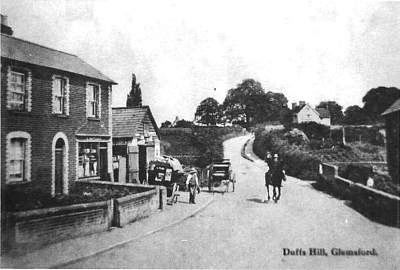

This is a transcript of a tape recording made by Ted Hartley of Glemsford, December 1978. The Hartley family had been wheelwrights in the village since at least 1750.
D.E.Weston, Clare Middle School
A photographic gallery of the postcards of Glemsford that were used to illustrate Ted Hartley's recollections is here, along with several more
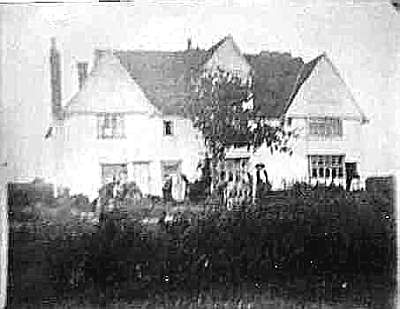
Starting our journey at Low Road at the bottom of Church Hill we come to Place Farm. Mr Spencer Bigg farmed this; it was a small arable farm with a few cows. The milk (skimmed) cost 2d a pint. My wife used to fetch the milk in cans from Moyse's Farm Boxted, over a mile away The choir boys were invited to listen to the first wireless in the village, which was set up on the lawn here - the best part of this was the slab cake and lemonade. Monks Hall used to be 3 cottages, occupied by Mr. Chatters, George Piper the manager of the silk Mill, and the Adams family. There was a deep well in front which supplied water for the houses.
Next we come to the Church. With my 3 brothers I had to attend as a member of the choir and he Sunday School.
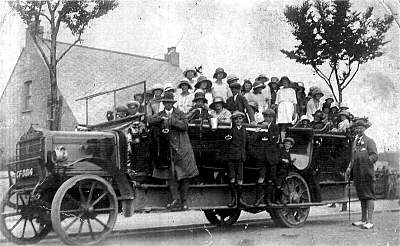
The choir outings included trips to the seaside and to the Wembley Exhibition We travelled by charabanc, these held 25 people, no roof, just a canvas hood, and we had to get out and push it up hills.
One brother of mine who was a bellringer once climbed over the parapet at the top of the church, and holding onto the top walked along the projection which was 4' down.
To the left of the church was Churchgate Farm, farmed by John Goodchild who was known as "Tapper", he also farmed Duffs Hill and Mill Hill farms, and he owned a portable steam engine drawn by 2 horses, which was taken to different farms to drive the pitcher or elevator, drum and chaff cutter. To the right of the church was Park Farm House, run by the Sterry family.
Further on towards Bells Lane stood the Prince of Wales Public House and opposite Jim Brown's shop and bakehouse. The bread oven was made of firebricks, faggots were put in it and set alight, left to burn out, the ashes were raked out and the dough put in - the end product was a crusty tasty loaf.
Windmill Row was a row of houses just before Tompkins Horsehair Factory. At one time 100 people worked there, mostly women. Going down Bells Lane we come to Arnold & Gould's Horsehair Factory, this also employed a large number. The men were called hacklers, they washed and combed (hackled) the hair ready for the women, these were called drawers, their job was to dress and form the hair into neat bundles. In the First World War part of the factory was used as a prison camp. The area is still referred to as the 'camp'. The German prisoners used to write messages, put them in matchboxes and throw them out of the barricaded windows to the young women.
Further down in Bells Lane was Bob Beales' garage, he had charabancs for hire, most of them and the lorries had solid tyres, with the rough roads you can imagine the ride. Then there was Mr. Middleditch, the shoe repairer.
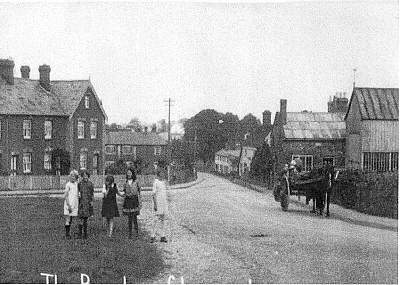
Now, the Broadway, and Alfred Gane's bakehouse and Post Office. After the bread was removed, housewives used to take pies to bake in the oven, which was still hot, this service cost Id or ll/2d. Then the Foundry run by Downs, this used to make the machinery for the matting industry. Just across the road was the Matchmaking Factory, employing quite a few men.
Making our way to Brook Street we come to Malyons shop, grocery and bakers, and in the same row of houses Mr. Elliott, optician and watch repairer. Opposite stood the hair and silk factory. Along the road before we get to the Crown Public House stood a flint and brick house, one room was used as a sweet shop - now demolished. Jimmy Jarman lived in Brook Street, he was the local postman, he had ladies and gents bicycles for hire at 4d per hour. At the bottom of Duffs Hill was Leo Smith's grocery and hardware shop, he was known as 'Shocking Smith' as he always complained of the shocking trade.
Across the road was the Crown Public House, and down Chequers Lane we come to the brook, which has steps leading to the water and a brick wall around the top. The brook has never been known to run dry. When the watertower was painted on the inside every 3 or 4 years, the water became undrinkable, so the villagers fetched brook water in cans and buckets. Next the Silk Mill with its large lake supplying the water which drove the huge waterwheel, which in turn drove the silk winding machines. In the 1920s the mill was flooded, Glemsford was hit by a cloudburst, water rushed through the houses in Brook Street, down Chequers Lane and into the mill, there was terrible damage.
By the way the locals always referred to the mill as the Silk Mal, the bell which was rung to let the employees know the time to start and finish work was called the Mal Bit, a small green on which stood a large chestnut tree was the Mal Bit, a playground for the Brookies.
Next we come to Duffs Hill Farm, owned and farmed by 'Tapper' Goodchild, and then on to Fern Hill and over the iron railings on the right side of the hill to the rough meadowland sloping down to the deep ditch or watercourse. This was known to all the boys and girls as the Squeech and further on a shallow part was called the 'Runnies'. Both of these, with their huge beech trees were favourite haunts of all the young boys and girls, especially in summer,
Back to the Broadway and approaching Lion Road, we come to Thompson; 'taylor' as he was known, and Thompson's sweetshop. Then on to Lambert's sweetshop and milk retail business, a very busy and popular shop.
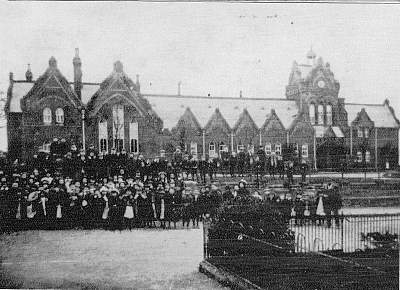
Now we come to the village School. Mr E. F, Wilson was the schoolmaster, very strict he was. Anyone misbehaving was given the stick. I can only remember having it once - when I pulled the handle off the porch door. We must have looked a motley lot then! Three-quarter length trousers, black stockings, some boys with wooden clogs with steel toe-caps. This school was of red and white brick and was built about 1871 at a cost of £3,000. Opposite the school was the Black Lion public house, Mr Challis was the landlord.
Then there was Bill Pearman's Blacksmith's shop, the only one in the village then. I remember him shoeing the horses and the unmistakable smell of burning hoof. We used to bang on the big doors and throw stones at the horses tethered outside.
Old Barny Farrance was quite a character. He used to sell bloaters, sprats, oranges and bananas, transporting his wares to different villages in a large box on pram wheels. Barny was asked "How much are your bananas?" "1 l/2d each, mate" he replied. "Well, let's have 4 for a tanner". "Can't do that mate, it cost me that much to buy 'em". What about the chap in the harvest field, caught a rabbit, broke it's neck, as he thought, laid it on a sheaf, turned around a moment later and saw it running away. He remarked "That's a rum'en. I killed that blooming thing once". "Is your sister Mary still alive, Bill?". 'Yes, as far as I know, she ain't writ to say any different". "There's a bus load going to the football match tonight, and another bus load going to bike!". "Poor old girl, she's as yellow as a pagle".
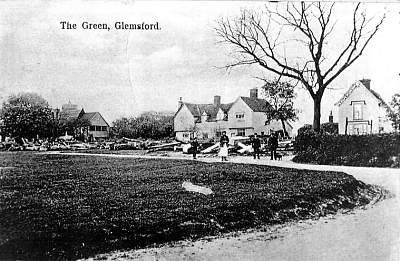
And so we come to Tye Green - best part of the village, I would say that as I was born in the old timbered house, now called Peverels. First, the butcher's shop ran by Mr Ambrose, he also had a slaughterhouse, we used to watch the animals being killed. After they were killed the butcher used to fling the bladders to us, these were then blown up, tied up and used as footballs - a bit grim but better than the rag balls.
The loading bay at Glemsford station was unsuitable for unloading animals, so this took place at Cavendish and we used to help drive the animals from there to Glemsford, Once a bullock lay in the middle of the road and refused to get up. A Cavendish boy put some water in the bullock's ear - the poor creature got up and ran all the way to Glemsford. Next door to there was the Hardwick Arms public house, now called the Cherry Tree.
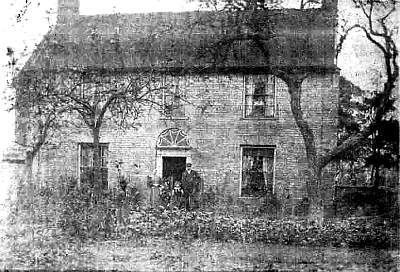
Then there was the Plough Inn, right in front of my house - a pub with a well kept garden with lovely peaches trained to the wall. There was a meadow close by where the village fair was held -Wright's Fair. 'Stinger Wright' provided the entertainment, he was very well known throughout West Suffolk. Mr Ezra Game, the landlord of the Plough used to smoke herrings in a shed behind the pub, using oak sawdust, shavings and bark from our old shop,
I mustn't forget Mrs Pegler's shop, adjoining the Hardwick Arms, she sold sweets, paperback books - 'Red Letter' 'Bessie and Billy Bunter'. We called her 'Bunny Pegler' as she had 2 large front teeth. Her aniseed balls were 40 for 1d., 12 hard toffees or 20 soft toffees for Id.
Over the road was our Wheelwrights, The Hartley family are known to have been wheelwrights from at least 1750.
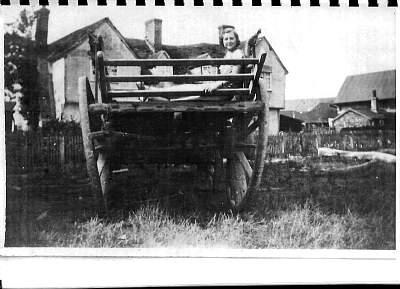
I left school before I was 14, my brother who helped my father, died of blood poisoning when he was 17, so I was given permission to leave school to help my father. I well remember my first job. My father was making a tumbril wheel. The nave was morticed and the spokes ready to drive in, he gave me a bucket and shovel and told me to fetch a bucket of fresh cow dung from the meadow behind our workshop. The end of the spokes were dipped in the dung and driven into the nave, the dung acted as a sort of glue. This method must have been used by my ancestors, because I've broken old naves and found dung inside.
Now, the workshops, the main one was in front, close to the Green with a shop above it for storing bolts, nails, paint etc. All our paint was made in a paint mill - I've spent hours turning the handle, with strict orders not to touch the adjusting screws. In the top shop my father used to finish small traps and carts, painting, varnishing and lining out. Two long heavy trucks were placed from the ground to the first floor and the carts hauled up by rope and pulley. A storeshed was behind the workshop, this housed the naves, felloe's, spokes (all of these riven), ash and oak planks, patterns and templates of all descriptions. The old lathe was in there as well with it's large wooden flywheel, a wooden treadle and various assortments of tools.
Behind the shed, the blacksmiths shop forge, bellows, vice, drills, tongs, lifting dogs and outside the tyreing platform. There was a tyre bending machine and a sunken pit for heating the tyres. Anyone who thinks a wheelwright's job is easy should try the bending machine. Put in a 3 1/2 by 5/8 iron bar and start turning the handles; or try a day welding at the forge, and then to the smoke and steam of shrinking the tyres onto the wheels, 'shoeing' as it was called.
The sawpit was about 10 or 12 feet long, 4 feet wide and 6 feet deep. I remember the water being pumped from the pit and the 2 Sawyers arriving. These 2 came from Brockley and used to travel to different villages to work. The log was placed over the pit and held firm by dogs, one man at the top, the other below using a pit saw.
Another job I had was ripping the waggon shaft from a 3 1/2" thick plank, it was as hard as blazes, the saw ran under and out, my father had to come and correct this, I was only 14. Old photographs of the Green in front of the shop show it absolutely full up with logs, tumbrils and waggons.
As boys we made 2 see-saws or 'teematawter' as they were called. One for the younger boys -an old binder pole over a log; for the bigger boys a long hefty sapling over a large oak log, 3 or 4 boys at each end, the idea was to bump the other side off, we used to play this most summer evenings. Every Armistice Day my father used to give the signal for die 2 minute silence by firing our canon, which was bolted onto a large block and placed between 2 heavy timbers. Talk about a bang! It was heard all over the village. Once a year before harvest a timber jim, a 2 wheeled vehicle with pole and chains was loaded with large timbers. Two large road waggons with double shafts, drawn by 2 horses and having 2 trace horses as well, were loaded with smaller logs and taken to Wheelers of Sudbury to be sawn into planks suitable for the trade. I travelled on one once, we loaded up the day before and set out for Sudbury at 6a.m. -quite a few people to see us off, We stopped on top of Skates Hill to have the brake shoes or slades put on the rear wheels, this locked one wheel. The trace horses were unhooked and tethered to the back - down the hill we went and got home a 8p.m., it was quite an occasion for a 10 year-old.
Next door to where we lived was a lady called Mrs Chatters, she used to have a loom in one of her rooms, weaving horsehair cloth. I used to take the finished cloth back to the factory in Brook Street and then bring another lot of work back to be woven. I got 2d for that.
There were many looms in the houses in the village. I've never actually seen this but it's true that women with babies attached their cradle to part of the loom and thereby rocked the baby to sleep.
Quite close to us was old Jed (Charles) Pettit the undertaker and builder. He too had a number of logs on the green, used for coffin boards and posts. I was asked to drive the horse and hearse back from the church, with very strict orders to walk the horse slowly -how I would have liked to gallop the old nag through the village. Adjoining Pettit's workshop lived an old gentleman who used to collect a lot of herbs and hang them out to dry on the fence and lay them on the Green. The large Green was used by us boys to play cricket, football etc., and also for religious meetings and political gatherings.
Round the corner to Cavendish Lane was Debenham's builders yard. I worked for him after my father died and so did Richard Deeks, much later. Some of our woodcarving is in the main roof of Cavendish Church.
Clockhouse Farm is at the top of Cavendish Lane and was farmed by Collis Goodchild (Old Collie), a "bite your head off' type. I remember the stackyard full of corn stacks and the ratcatcher coming with his ferrets, one or two of which were thrown on the top of the stack to chase out the rats. Those which came out of the top and sides were shot, and the dog snapped up those which fell to the ground. During thrashing time we used to go to the farm with sticks to help kill mice and rats. Old Collie had a rather fierce red poll bull. On Sundays we used to tease the bull, it pawed the ground and made horrible noises before starting to chase us, we always managed to vault over the gate in time, but on one occasion it went straight through the gate and we had to climb trees to avoid it.
There were 5 ponds in the meadows behind our house and we used to get a long stick, tie a spoon to the end and lift out moorhen eggs; we also climbed trees and robbed owls' nests, we had to bend the spoon for that. My father explained how the ponds came to be there - clay was dug out to make clay lumps or bricks and to help make wattle panels.
New Street Farm up a road branching off Cavendish Lane was farmed by Collie Goodchild, in a meadow beside the farm was a sunken pit used as a sheep dip, a pond close by supplies the water. Collie and Tapper both kept sheep and employed a shepherd who, during lambing time, spent a lot of time in the Shepherd's Hut. This was about 6 feet wide, 10 feet long of matchboard outside and lined inside, the cavity packed with fibre from the matting factory, a small tortoise stove for heat, the roof also lined. We made and repaired several of these. Small waggons were used by the flax factory, some were bought by local farmers. Although not suitable for farming, the buck was taken off and the shafts wheels and undercarriage used for the huts; it was then horse drawn to the field.
Another thing we made was the iron hurdle - 12 to 14 feet long and 3 feet high with 2 small cartwheels back and front. Seven or eight of these were linked together and drawn by horse from field to field. When they came through the village they could be heard a mile away because of the screeching wheels and the rough roads. This noise was a cue for us boys to run down the road, hop on and have a ride, the shepherd tried to frighten us off, but he could not control both and if a person was very ill in bed, straw, chaff or caven was strewn in the road in front of the house to deaden the sound of farm vehicles. This happened when my father died.
Plum Street was a narrow road from New Street to Mill Hill Farm, leading from here was a footpath and cart track to what we called Hilly Mountains or the Hillies, a rough meadow with a sandpit at the top, sloping down to a deep ditch or watercourse, 20' deep in places, and more than that across, completely overgrown with bushes - a favourite place for the boys. Shepherds Lane led from the farm to the school, in a meadow down there were 12 large poplar trees, known as the 12 disciples and before we got to the school were 3 large elms known as the 3 sisters. All 15 trees have now gone.
The children from the school down to Brook Street and up to Churchgate were called the "Brookies" and from Tye Green to the station "Downies" - there was great rivalry between them. Towards Hunts Hill nearly opposite our sawpit was Billy Raymond's orchard, 2 large houses there now.
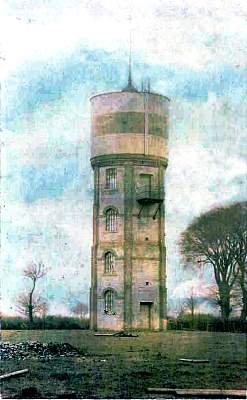
Across the road was Fenn's bakehouse, and further on Tower meadow and the water tower, part of which was the surveyors office, Mr Taylor, he collected the rates, it was then an Urban District Council. The outside of the tower was painted with aluminium paint and could be seen for miles. It is demolished now, as the metal tank had rusted.
On the left of the road towards Hunts Hill was the Methodist Chapel, which I remember being built. Further on Felix Underwood's shoe shop, he had a horse and cart to carry his wares around the villages, the old horse stopped at every pub; later he had a model T Ford.
Next along the road was the old school used as a Sunday School in my youth. Dances and other entertainments were held there, 6d hops were popular -1 met my wife at one - quite a good bargain for a tanner! Other week nights were taken over by the Mens Institute where we played billiards, darts, cards. The most popular game was bridge which we learnt by watching the experts, the schoolmaster, rector and other nobs. You could join at 14, misbehave and you were banned. Across the road was the Dentist, I had a tooth out when I was 12 - how I screamed! Once he got the pincers on your tooth he never let go, it was your head or your tooth. Nearby was a small building where the village fire engine was kept, it had to be pulled by the firemen who were council workers.
Box iron Row were houses built for the weavers, old Charlie Elsdon lived there; he was always called 'Show'. He was a poacher and kept his ferrets in the pantry. Nearby was Neely Brown's fish shop, he also collected rabbit skins, he lived in a thatched house. In another pair of thatched houses near the fire engine shed lived old Ezra Slater who gathered watercress from the River Stour and sold it in the village, he also bought rabbit skins, Mr Bigmore's horsehair factory was nearby - all the above have been demolished. Mr Millam had a fish shop next to the hair factory, he travelled by horse and cart selling fish and collecting rabbit skins (7 or 8 folk collected skins, they fetched 3d or 4d each).
The Baptist Chapel, now demolished, adjoined the fish shop, the graveyard is still there. At the top of Hunts Hill on the right was Longs grocery shop and, on the left, Longs garage. They owned a charabanc, at first with solid tyres, had cars for hire and later lorries and buses.
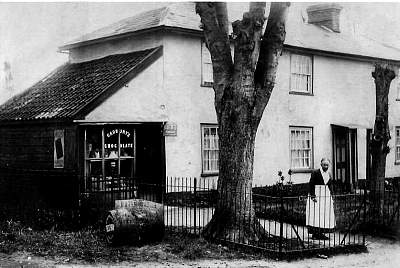
Next to Longs grocery shop was Mrs Maxim's sweet shop and tobacconist, her husband was the local carrier, he often took templates and patterns of shafts, plough beams etc. to Wheelers of Sudbury to be cut, they were brought back the same day, the charge was 1/-. His cart had brass caps on the wheels inscribed "Hartley, Wheelwright, Glemsford". On the same site a butchers, Bullingham and Maxim (son and son in law). Opposite was a small matting factory ran by the Smith brothers, now demolished. In the middle of the hill a row of cottages now demolished.
The British Legion Hut was built on that site, it's gone now. On the right of the road, Mr Cranfield's sweet shop and barbers. Next door in a house standing back from the road lived Mr Taylor, known as 'Motorman Taylor', the first man in the village to own a car - a Daimler. At the top Workhouse Lane (now Flax Lane) was a deaf and dumb shoe repairer, you had to write on a slate what repairs you wanted. Directly behind this house were several dilapidated thatched houses, the site known as Mitre Square, all gone now.
Down the lane on the right was a large orchard (Lee's garage and houses there now). Next the Flax Factory built on the site of the old workhouse. I remember it in operation, you could smell the stench a mile away - this was the 'retting' or rotting of the flax. At the bottom of Angel Lane Mr Lee's draper and grocery shop and opposite the Angel pub and the Angel House, one of the oldest in the village. At the top of Angel Lane Enoch Watkinson's small matting factory. Further on was Grove Farm then owned by Mr Fuller. A cart track and footpath led to a field called Hanging Hill, at the bottom of the field was Bill Gobbler's smallholding, he kept pigs, turkeys and chickens. He once boasted he had shot a white rook and later found it was one of his own chickens.
Now Egremont Street, first on the left is Art Chinery's shoe. shop - he's still there, aged 84, he started the business in 1902. Over the road the Ebenezer Chapel, next door to that Silas Game's bakehouse. Pump Lane is close by with thatched houses and a pump. The Cock public house, Copsey's butchers shop and Cuttings wholesale grocers are all together. Then Bretts the coal merchant, he lived in another thatched house.
Down the road on the left another horsehair factory and directly behind a small chapel called the Renters. Then Jo Gridley and his fried fish shop, he sold whelks and cockles and also collected rabbit skins. He had a stall at the village fair, opposite the Greyhound house which used to be a pub. Next door a small chapel, an iron building we called it the 'Tin Tab' (Tabernacle). Then a coalshed belonging to W. Taylor, the landlord of the Angel, and quite near a bakehouse ran by Mr Cable, and a newsagent and sweetshop owned by Mr Sawyer.
Alongside the shop another large matting factory. Then the cul de sac called New Cut, off Egremont Street, at the top an off licence (The Weavers Arms), landlord was Walter Goodey, he was a plumber, painter and glazier.
Skates Hill Farm is next, owned by Collie Goodchild and the Lodge Farm also owned by him.
At the bottom of Skates Hill, on the left, Potash House, owned by Mrs Twinn, she kept a lot of chickens which used to run in the road. As boys we used to catch a few and put them to sleep and plate them across the road, (place the chicken's head under it's wing, with both hands around it's body and wings, one or two complete circles and lightly place it on the ground, it stops there 2 minutes or more and gets up as if nothing had happened). I did that to my mother-in-law's chickens once, she thought they were all dead.
At the end of the village was an old lady called Rosie Byford, she kept 2 or 3 cows and supplied milk to the locals.
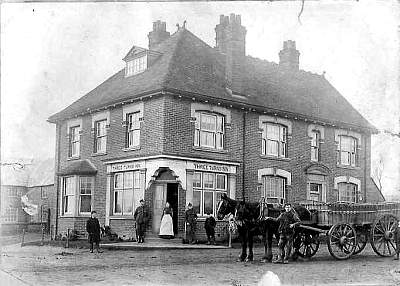
Then the Three Turns pub at the bottom of the hill, to the rear of this another Matting factory. I can't remember it in operation.
The Lower Road was known as the Chicken run and was where people from Glemsford, Cavendish, Foxearth and even Long Melford used to walk, meeting and talking, the young ladies showed off their Easter rig-outs - many a romance blossomed from the Chicken run.
Then Glemsford Station. Mr Herrow was the station master, very smart in his uniform.
Across the River Stour on a rough patch of ground was a gypsy encampment - a gypsy was murdered here - shot at point blank range by a well-known gyppo Bill Munday, he got off through self defence. Gypsies were called gyppos or diddycoys. An old well-liked character who lived rough summer and winter in the hedgerows and thickets was Jerry, the scissor grinder, nobody knew his real name, he roamed the villages sharpening knives and scissors on his contraption. I wonder if boys of today would do this!
We used to eat the young tender shoots of the briar (wild roses), just the first 6", also young shoots of the hawthorn, we called this 'bread and cheese', also the red fleshy berry of the fir, (not the seed), hips and haws-and even the flowers of the primroses.
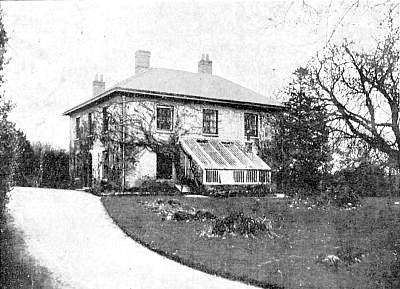
Finally, a few words about the Old Rectory. It was a spacious house set amongst chestnut and beech trees with large cellars, hothouse, greenhouse, conservatory, beautiful gardens and well kept lawns. I first remember Canon Hall living there, after him the Rev. Banks-Williams - he left me his watch in his will. We were allowed to pick mulberry leaves from a tree on the lawn to feed our silk worms. The village flower show was held in , the rectory meadow. This attracted visitors and the gardens were open to visitors. Dancing to the Long Melford Brass Band took place on the rectory lawns. The Girl Guides had a very successful group, the Rector's daughter Irene Banks-Williams formed a group in the early 1920s. My wife was a guide and she's told me her group was always first to get a fire going at camp. They peeled a silver skin of a Silver Birch, placed it under dry twigs and just see how quickly it burns!